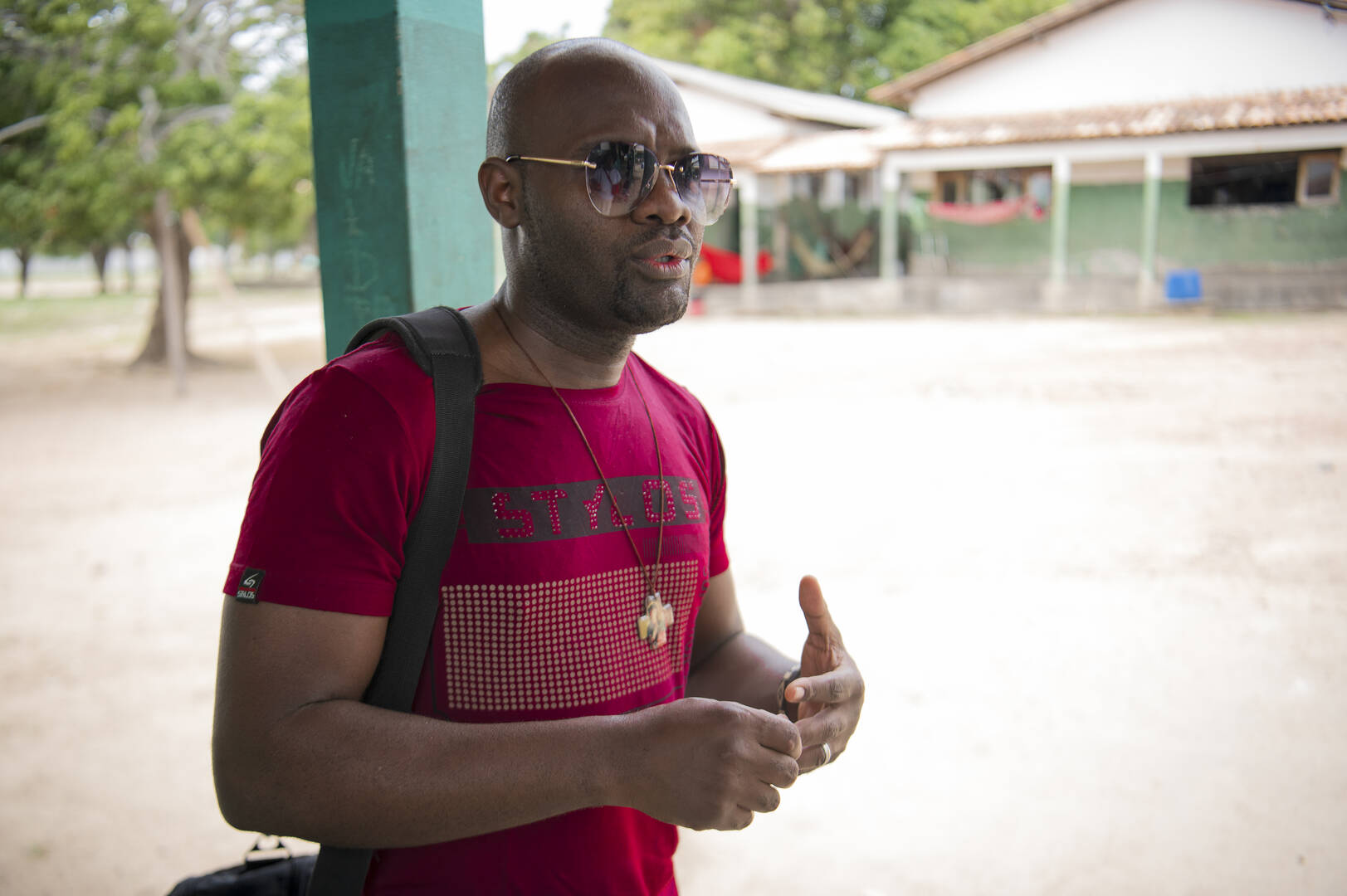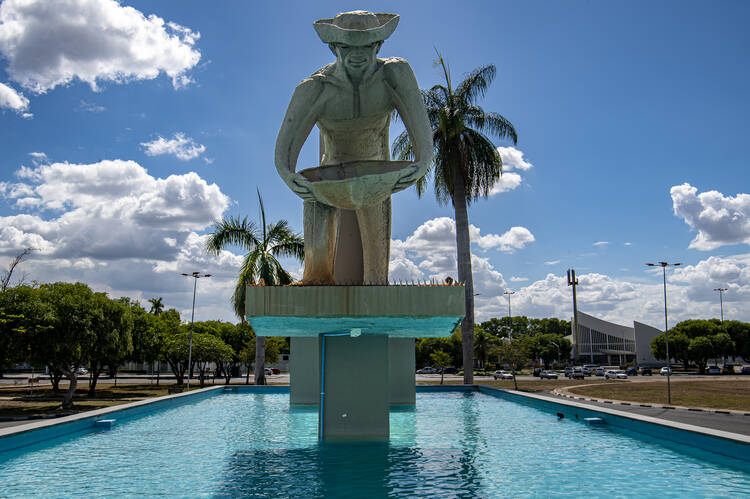It has been a year since Brazilians woke to news of famine and hundreds of children dead from malnutrition and preventable diseases in Yanomami Territory. Now, Brazil’s most celebrated Indigenous community is slowly recovering from what some had characterized as an attempted genocide. That is according to missionaries and Evaristo Spengler, O.F.M., bishop of Roraima, who spoke with America this month.
Over the four-year administration of President Jair Bolsonaro, between 2019 and 2023, 570 Yanomami children perished as 20,000 wildcat miners, known in Brazil as garimpeiros, tore up the forest in what should have been protected Yanomami territory, seeking gold, tin and minerals used in contemporary hi-tech products.
The Yanomami live in a vast territory about the size of Portugal on Brazil’s border with Venezuela. Out of a population of approximately 30,000 people, those 570 deaths represent nearly 2 percent of the Yanomami population. It is as if 6.6 million Americans had died over four years, all of them under the age of five.
The expansion of the prospectors’ reach into Indigenous territories was broadly encouraged by the Bolsonaro government, to devastating effect.
“In relation to the Yanomami, I have no doubt at all [it was genocide],” Bishop Spengler told America in an interview that was translated, like others in this report, from Portuguese. “The previous [Bolsonaro] government denied safe drinking water and medication when there were reports that the Indigenous were dying,” he said. “The project of, in fact, exterminating the Yanomami was so that the territory would be available for the garimpeiros and other natural resource projects. There is no other name for this other than genocide.”
The expansion of the prospectors’ reach into Indigenous territories was broadly encouraged by the Bolsonaro government, to devastating effect. The garimpeiros poured mercury into rivers, raided and occupied government health stations intended for the Yanomami, used Yanomami girls as cooks and sex slaves and intimidated entire Yanomami communities.
Brazil’s historical relationship with garimpeiros is complex. In much of Brazil, they are celebrated as tough, adventurous, entrepreneurial men of the frontier. In downtown Boa Vista, the capital of Brazil’s State of Roraima near the border with Venezuela, an enormous statue of a garimpeiro panning for gold dominates the square facing the state legislature. At the same time, many of today’s garimpeiros are financed by drug gangs, who launder narco-profits through Brazil’s loosely regulated gold markets.

The plight of the Indigenous communities has drawn greater attention since Luiz Inácio Lula da Silva became president. He visited Boa Vista during his first week back in office last January. Mr. Lula had previously served two terms as president between 2003 and 2011.
But that visit hardly means the threat to the Indigenous community has been resolved, said Bishop Spengler, a former president of the National Conference of Brazilian Bishops’ commission on human trafficking and current president of the Brazilian section of R.E.P.A.M., an ecumenical network of religious leaders from the eight countries that comprise the Amazon basin.
Over the four-year administration of President Jair Bolsonaro, 570 Yanomami children perished as 20,000 wildcat miners, known as garimpeiros, tore up the forest.
The Brazilian Ministry of Health has recorded 308 deaths in Yanomami territory in the first 11 months of 2023; 343 deaths were recorded in 2022. Of the deaths in 2023, 162 were children, including 104 infants. Deaths peaked in the second half of 2023 with cases of malaria, flu and diarrhea blazing through the territory.
The Lula government spent $70 million restoring a destroyed health service in Yanomami Territory in 2023 and is committed to spending another $242 million to address the emergency this year, but the results so far have fallen short of expectations.
Bishop Spengler remains concerned that “Brazilians have shown that they don’t have the capacity to manage this situation.”
Last year’s headlines and photos of starving children with distended bellies were a wake-up call for Brazilian society, according to Bob Franks, I.M.C.. Those images “opened eyes,” Father Franks said. “One way or the other, it frightened those who were in charge, who were not doing their work, to wake up and at least do something.”
Since then “things are getting better and better,” said Father Franks. A Yanomami speaker, he lives among the Yanomami most of the year, organizing activities for Yanomami youth, at Catrimani, a small and isolated mission community in Roraima state.
Whether the damage of the Bolsonaro years can ever be repaired, there is no mistaking the character of the disaster in Yanomami Territory, Gilmara Fernandes Ribeiro said. “It was a genocide,” she said. “It is clearly connected to colonialism—neo-colonialism.”
Last year’s headlines and photos of starving children with distended bellies were a wake-up call for Brazilian society.
Ms. Fernandes is the director for Brazil’s northern region for C.I.M.I., the Conselho Indigenista Missionário, an organization for missionaries in Brazil created by the Brazilian bishops.
Corrado Daldonego, I.M.C., has lived with the Yanomami. He believes that it will prove difficult to make a charge of genocide stick. The Haximu massacre, a slaughter of Yanomami villagers by gold miners in 1993, was called a genocide by many—and was recognized as such by Brazil’s supreme court in 2006—but proving intent to eliminate the Yanomami was difficult. The same question surrounds Yanomami’s loss of life during the Bolsonaro years—did the government explicitly intend to wipe out the Indigenous people?
“Basically, were there intentional and deliberate actions taken to extinguish a people as such? This is what characterizes a genocide,” said Father Daldonego.
A substantial record of public statements does testify to Mr. Bolsonaro’s desire to remove Indigenous people and their constitutionally guaranteed right to protected territory, which he regarded as an obstacle to economic development. He has compared isolated Indigenous people to animals in a zoo. In 2020 he said, “Indians are undoubtedly changing…They are increasingly becoming human beings just like us.”
Mr. Lula’s efforts to get the garimpeiros out of Yanomami Territory over the last year have not entirely succeeded, despite a number of raids by IBAMA, the Brazilian Institute of Environment and Renewable Natural Resources, with support from the Brazilian military. Davi Kopenawa is a Yanomami shaman and president of the Hutukara Association of Yanomami. He recently told Brazilian media that the Yanomami are still threatened by the miners.
“They’re like termites. Half of them left. The criminals stayed,” he told Folha, one of Brazil’s largest newspapers, one year after Mr. Lula declared a health emergency in Yanomami Territory.
Young Yanomami are becoming aware of their rights and are willing to fight for their communities.
Soon after IBAMA and Brazilian armed forces burned 34 small aircraft and destroyed 362 mining camps—complete with StarLink equipment for satellite Internet access, earth-moving equipment, boats and generators—the vast majority of the garimpeiros left the region. IBAMA claims to have reduced illegal mining activity by 85 percent, but government agencies estimate 3,000 territorial invaders have permanently settled on Yanomami land.
Since the health emergency in the Yanomami community was declared, 766 tons of food and other materials have been transported into Yanomami territory, and more than 36,000 food baskets have been distributed. Many are dropped near Yanomami communities from helicopters. During the Bolsonaro years, many nurses and other health clinic workers left the region after threats from gun-toting garimpeiros who were emboldened by support from the Bolsonaro administration.
Now, under Mr. Lula, many health workers have returned. Back at their health stations this year, nurses, nutritionists and doctors conducted 3,029 consultations. Clinics that serve the Indigenous community are working at twice their official capacity, dealing with illnesses and malnutrition that had previously been unaddressed. Over 200 Yanomami have been flown out of Indigenous reserves for medical treatment in regional hospitals.
Most important, young Yanomami are becoming aware of their rights and are willing to fight for their communities, Father Franks said. In the last year, Father Franks witnessed four young Yanomami who went to the local health station to prevent nurses there from distributing malaria medication intended for Yanomami to garimpeiros in the area.
“They said, ‘No, this is ours. They [garimpeiros] are from outside. They are white. They have everything to buy for themselves and [still] they want to take what is ours,’” Father Franks recalled. “I remember that day… [the garimpeiros] went back to their mining [sites] without medicine.” He was deeply impressed by the assertiveness he witnessed. “That is why I’m saying, ‘We have hunger, but mighty hope.’”
Bishop Spengler is certain about which side the church is on in this continuing struggle.
“If a church wasn’t against death, wasn’t against genocide, it wouldn’t be evangelical,” he said. He thinks the moves initiated by the Lula administration—its declaration of a health emergency for the Yanomami—begin to move Brazil back from the brink of genocide, but he was careful to emphasize that a serious threat to the Yanomami people remains “in health, food and all the life conditions they are facing.”
Michael Swan and Yone Simidzu reported from Boa Vista, Roraima, Brazil. Their visit to the Yanomami region was sponsored by Development and Peace—Caritas Canada.








